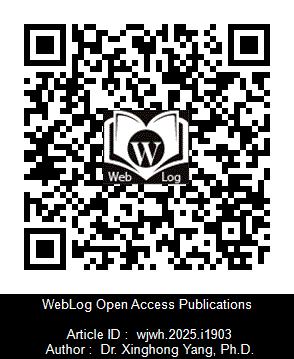
ARTICLE TYPE : RESEARCH ARTICLE
Published on : 19 Sep 2025, Volume - 1
Journal Title : WebLog Journal of Women’s Health | WebLog J Women's Health
Source URL: ![]() https://weblogoa.com/articles/wjwh.2025.i1903
https://weblogoa.com/articles/wjwh.2025.i1903
Permanent Identifier (DOI) :  https://doi.org/10.5281/zenodo.17283030
https://doi.org/10.5281/zenodo.17283030
Dysmenorrhea: Underlying Mechanism and Curing Solutions
Abstract
Abstract: Dysmenorrhea remains a prevalent gynecological issue among women of reproductive age, often causing significant physical and emotional distress. Conventional medical treatments, such as analgesics and hormonal therapies, frequently offer only partial or temporary relief, leaving many women to endure chronic pain. In recent years, increasing attention has been given to psychosocial and spiritual interventions for managing persistent health conditions. However, the potential of Buddhist practices, particularly those within the Guan Yin Citta Dharma Door (心灵法门), in alleviating long-standing dysmenorrhea has been largely underexplored in medical literature. Mainstream research rarely addresses the spiritual or karmic dimensions of illness, creating a gap in understanding alternative approaches to healing. This case series examines four women with severe, persistent dysmenorrhea, some compounded by endometriosis or other comorbidities, who achieved complete symptom relief through Buddhist practices. These practices, rooted in the teachings of Dharma Master Jun Hong Lu (卢军宏), include making vows (许愿), reciting Buddhist scriptures (念经), performing life liberation (放生), and so on. Master Lu’s teachings propose that dysmenorrhea is a karmic condition with spiritual manifestation, requiring the resolution of karmic obstacles (消业障) and the ascension of spiritual entities (超度灵性) for true recovery. The outcomes observed in these cases suggest that these practices, by addressing the spiritual etiology of dysmenorrhea, may offer a novel and effective approach for women with refractory symptoms. T hese findings highlight the need for further clinical research to explore the efficacy and mechanisms of Buddhist practices in curing dysmenorrhea, potentially broadening the therapeutic options available to women worldwide.
Keywords: Guan Yin Citta Dharma Door; Golden Buddhist Practices; Dysmenorrhea; Karma; Spirits; Recovery
Citation
Xinghong Yang. Dysmenorrhea: Underlying Mechanism and Curing Solutions. WebLog J Women's Health. wjwh.2025.i1903. https://doi.org/10.5281/zenodo.17283030